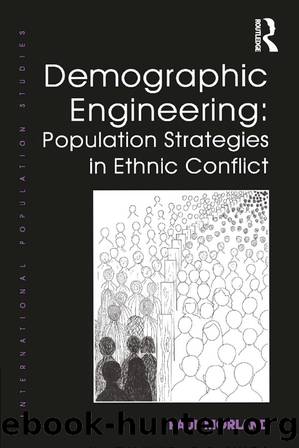Demographic Engineering: Population Strategies in Ethnic Conflict by Paul Morland

Author:Paul Morland [Morland, Paul]
Language: eng
Format: epub
Tags: Social Science, Demography, Political Science, Political Ideologies, Nationalism & Patriotism, Geopolitics
ISBN: 9781472441669
Google: VznjBAAAQBAJ
Publisher: Ashgate Publishing, Ltd.
Published: 2014-10-28T05:09:42+00:00
Explaining Catholic Fertility
Catholic fertility in Northern Ireland was high relative to that of Protestants at least from the 1920s to the 1990s, but this itself does not make the case for demographic engineering. Such a case is difficult to make where fertility is concerned since what is required is an understanding of the reasons behind peopleâs fertility choices. In the absence of surveys into those reasons, we need to adopt a variety of approaches to test whether the fertility of Catholics in Northern Ireland does indeed meet our criteria for demographic engineering.
First it is worth taking note of general theoretical and empirical work on the question of whether the family sizes and fertility choices of minority populations can be seen as to some extent resulting from their minority status per se rather than from any particular cultural, economic or other characteristics. The general view which emerges from the scholarly literature is that minority status can indeed independently impact fertility, but the way in which it does so is highly contingent upon the minority in question and minority status can both raise and lower fertility (Day 1968; Goldschneider and Uhlenberg 1969; Sly 1970; Ritchey 1975; Jiobu and Marshall 1977).
Second it is necessary to look at Catholic fertility in Northern Ireland in the context of general Catholic fertility. This helps prise apart explanations based on demographic engineering from those arising from the pronatalist and anti-contraceptive teachings of the Roman Catholic Church. It has been observed that Catholic fertility and birth rates across the developed world were generally higher in the immediate post-war years than those of Protestants. (In regard to Europe, see Chapter 1 Figure 1.4. In regard to the USA see Westoff and Jones 1979.) This tendency ceased to apply in the USA by the 1970s and in Europe by the mid-1980s. In the period in which Catholic and Protestant fertility fully converged in other parts of the developed world, it only began to converge in Northern Ireland.
High Northern Irish Catholic fertility rates cannot therefore be attributed to Catholicism alone. Could they however be attributed to specifically Irish cultural phenomena? After all, as has already been shown (see Chapter 1 Figure 1.4), the transition to low fertility rates in the Republic of Ireland has been late compared to those of other European Catholic states. It is therefore worth comparing Catholic fertility rates on the two sides of the border.
Kennedy (1973) shows that between 1926 and 1961, Catholics in Northern Ireland had a consistently higher âchild/woman rateâ9 than their co-religionists in the Republic, 6 per cent higher in 1936/1937, 13 per cent higher in 1946/1951 and 12 per cent higher in 1961. Estimates of the crude birth rate yield similar results. Adjusting for class status and looking at women aged 25-29, Kennedy finds that in every social group the number of children born per woman aged 25-29 in the year 1961 was higher in Northern Ireland than in the South, ranging from 4.39: 3.65 for employers and managers to 4.84: 4.28 for agricultural workers.
Download
This site does not store any files on its server. We only index and link to content provided by other sites. Please contact the content providers to delete copyright contents if any and email us, we'll remove relevant links or contents immediately.
Cecilia; Or, Memoirs of an Heiress — Volume 1 by Fanny Burney(32495)
Cecilia; Or, Memoirs of an Heiress — Volume 2 by Fanny Burney(31909)
Cecilia; Or, Memoirs of an Heiress — Volume 3 by Fanny Burney(31892)
The Great Music City by Andrea Baker(31756)
We're Going to Need More Wine by Gabrielle Union(19003)
All the Missing Girls by Megan Miranda(15774)
Pimp by Iceberg Slim(14433)
Bombshells: Glamour Girls of a Lifetime by Sullivan Steve(14021)
For the Love of Europe by Rick Steves(13558)
Talking to Strangers by Malcolm Gladwell(13290)
Norse Mythology by Gaiman Neil(13278)
Fifty Shades Freed by E L James(13186)
Mindhunter: Inside the FBI's Elite Serial Crime Unit by John E. Douglas & Mark Olshaker(9260)
Crazy Rich Asians by Kevin Kwan(9220)
The Lost Art of Listening by Michael P. Nichols(7453)
Enlightenment Now: The Case for Reason, Science, Humanism, and Progress by Steven Pinker(7272)
The Four Agreements by Don Miguel Ruiz(6700)
Bad Blood by John Carreyrou(6581)
Weapons of Math Destruction by Cathy O'Neil(6214)
